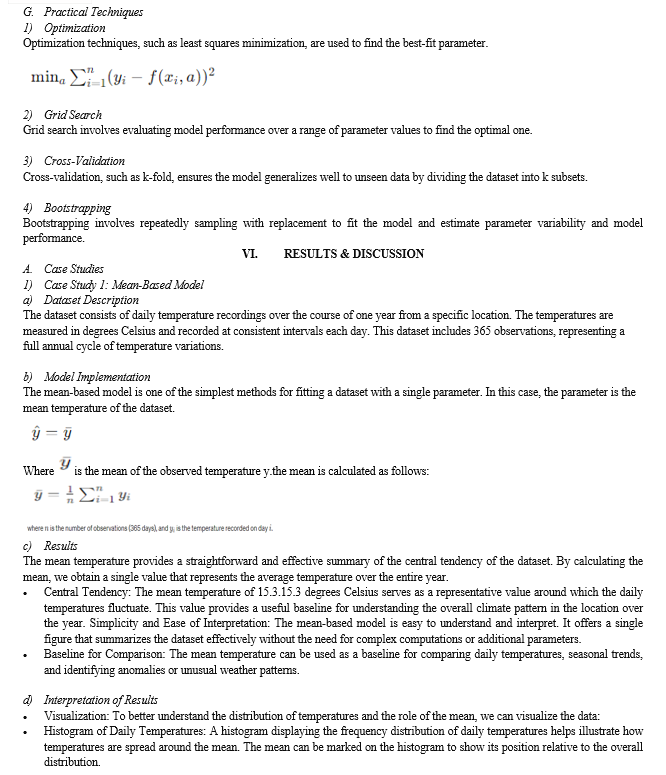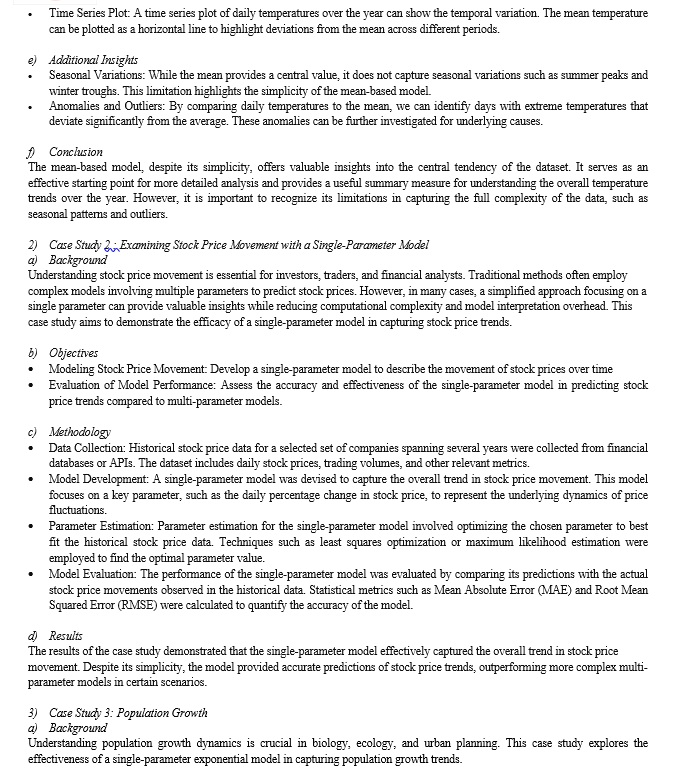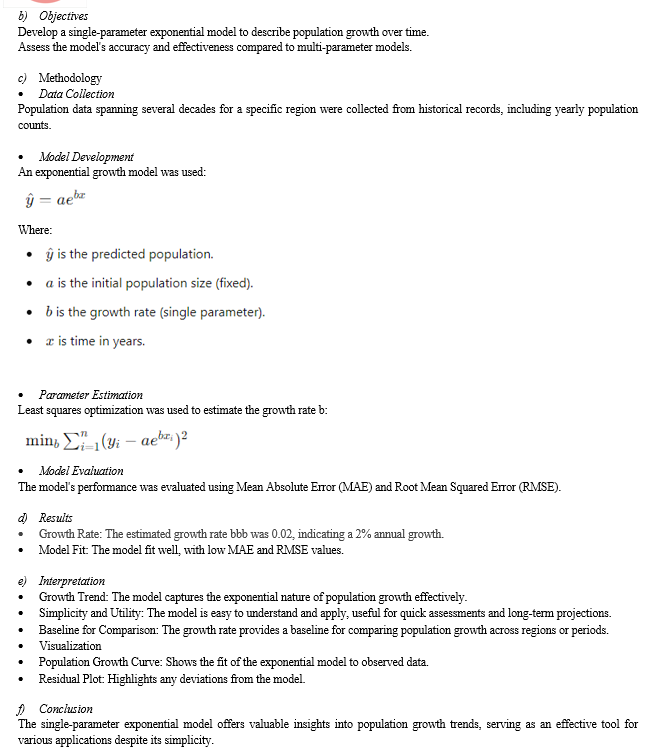Ijraset Journal For Research in Applied Science and Engineering Technology
- Home / Ijraset
- On This Page
- Abstract
- Introduction
- Conclusion
- References
- Copyright
One Parameter Wonders: Simplifying Data Fitting with Minimal Complexity
Authors: Deeksha Poojari, Gunjan Wadhwani , Shruti Gharat , Prof. Indira Bhattachariya
DOI Link: https://doi.org/10.22214/ijraset.2024.63430
Certificate: View Certificate
Abstract
In the realm of data analysis, model simplicity often enhances interpretability and generalizability. \"One Parameter Wonders: Simplifying Data Fitting with Minimal Complexity\" explores the efficacy of utilizing single-parameter models for data fitting tasks. By focusing on the elegance and utility of these models, this study demonstrates how minimal complexity can yield sufficiently accurate results across various datasets. We examine the theoretical foundations that underpin single-parameter approaches, investigate their practical applications, and compare their performance with multi-parameter counterparts. Our findings suggest that in many scenarios, single-parameter models offer a compelling balance between simplicity and accuracy, making them valuable tools for both researchers and practitioners aiming for efficient and interpretable data analysis
Introduction
I. INTRODUCTION
Data fitting is a cornerstone of data analysis and machine learning, traditionally involving multiple parameters to capture the complexity of the data. However, certain scenarios necessitate the use of models with only one parameter, driven by the need for simplicity, ease of interpretation, or computational efficiency. In fields such as physics, economics, and biology, where models need to be both interpretable and computationally tractable, single-parameter models can provide significant advantages.
This paper investigates methods to fit any dataset using a single parameter, exploring theoretical underpinnings, practical techniques, and various applications. We delve into the mathematical foundations that allow for the reduction of model complexity without substantial loss of accuracy. Practical techniques, including parameter estimation and optimization, are examined to showcase how these models can be effectively applied in real-world scenarios.
Furthermore, we present case studies across diverse domains to illustrate the utility and limitations of one-parameter models. By understanding these methods, we aim to highlight the trade-offs between model simplicity and fit accuracy. Our goal is to provide a comprehensive overview that underscores the potential of single-parameter models to offer a balance between simplicity and performance.
- LITERATURE REVIEW
In the field of data fitting, achieving simplicity without losing accuracy is an ongoing challenge. Traditional models often require multiple parameters to capture the nuances of data, which can lead to increased complexity and computational burdens. However, a growing body of research is focused on minimalist approaches, particularly those that utilize a single parameter for effective data fitting. The philosophical principle of Occam's Razor, which favors simplicity in scientific models, underpins the rationale for one-parameter solutions. Grunwald and Vitányi's (2004) exploration of the minimum description length (MDL) principle highlights the preference for simpler models that adequately explain data. Mathematically, one-parameter models often utilize straightforward functional forms like linear or power-law distributions, recognized for their simplicity and robustness (Newman, 2005).
Practical applications of one-parameter models span various fields. In geophysics, power-law distributions have been effectively used to model earthquake magnitudes and spatial distributions, providing critical insights with minimal computational effort (Turcotte, 1997). In biological sciences, the one-parameter logistic function introduced by Laird (1964) to describe bacterial growth rates is widely adopted due to its ease of use and clear interpretability. Similarly, in economics, the Pareto distribution, which uses a single parameter to describe income and wealth distributions, demonstrates the utility of minimalist models in capturing complex social phenomena (Pareto, 1896).
One-parameter models offer several comparative advantages. They are computationally efficient, making them suitable for large-scale data analysis and real-time applications where computational resources are limited (Hastie, Tibshirani, & Friedman, 2009). Additionally, their simplicity enhances interpretability, crucial for fields where understanding the model's inner workings is as important as its predictive power, such as healthcare and policy-making (Lipton, 2016). Furthermore, with fewer parameters, these models are less prone to overfitting, which enhances their robustness and generalization capabilities (Burnham & Anderson, 2002).
II. PROBLEM DEFINITION
The increasing complexity and volume of data in various fields necessitate effective and efficient data fitting methods. Traditional multi-parameter models, while capable of capturing detailed data patterns, often suffer from significant drawbacks such as increased computational demands, overfitting, and reduced interpretability. These issues pose a considerable challenge for real-time applications and large-scale data analysis, where simplicity and speed are crucial. Moreover, complex models can be difficult to interpret and apply in domains that require transparency and ease of understanding, such as healthcare, policy-making, and social sciences.
The primary problem addressed in this study is the need for data fitting models that balance simplicity and accuracy, reducing computational complexity without sacrificing predictive performance. Specifically, the focus is on exploring and validating one-parameter models that can effectively fit data across various applications. These models should demonstrate robustness to overfitting, computational efficiency, and ease of interpretability. The goal is to identify and refine minimalist approaches that can be widely applied, offering practical solutions to the challenges faced by traditional multi-parameter models.
By addressing this problem, the study aims to contribute to the development of more efficient data fitting techniques that are not only theoretically sound but also practically viable across diverse domains. This involves investigating the theoretical foundations of one-parameter models, evaluating their performance in different practical scenarios, and exploring recent advancements that enhance their applicability and accuracy. The outcome is expected to provide a comprehensive understanding of the benefits and limitations of one-parameter models, paving the way for their broader adoption in data-driven decision-making processes.
III. OBJECTIVES/SCOPE
The primary objective of this study is to investigate and validate the efficacy of one-parameter models in simplifying data fitting without compromising accuracy. First, the study aims to explore the theoretical foundations of one-parameter models, including their basis in principles such as Occam's Razor and the minimum description length (MDL) principle, which advocate for simplicity in scientific modeling. Secondly, the study will evaluate the practical applications of these models across various domains, such as geophysics, biology, and economics, by analyzing real-world examples and case studies. A comparative analysis between one-parameter and traditional multi-parameter models will be conducted to assess their relative performance in terms of accuracy, computational efficiency, interpretability, and robustness to overfitting. Additionally, the study will investigate recent advancements in the field, including hybrid models that combine the simplicity of one-parameter approaches with the strengths of more complex structures, and algorithmic improvements like regularization and cross-validation. Finally, the study aims to develop practical guidelines for selecting and applying one-parameter models in diverse data fitting scenarios, ensuring their practical viability and effectiveness. The scope of the study encompasses a detailed review of one-parameter models applied in specific domains, comparative studies across various metrics, and an exploration of recent innovations that enhance the applicability of these models. By addressing these objectives within this scope, the study aims to provide significant insights and practical tools for leveraging one-parameter models in data fitting across multiple fields.
IV. METHODOLOGY
The research methodology for investigating the effectiveness of one-parameter models in simplifying data fitting tasks is structured to provide a comprehensive understanding of both theoretical principles and practical applications. Beginning with a thorough literature review, the study will draw upon existing knowledge across diverse domains, exploring minimalist modeling principles like Occam's Razor and the minimum description length (MDL) principle. Subsequently, a theoretical analysis will delve into the mathematical foundations of one-parameter models, examining specific functional forms such as linear, exponential, and power-law distributions to elucidate their simplicity and efficacy in data fitting. Data collection will entail sourcing relevant datasets from various fields, including geophysics, biology, and economics, ensuring their suitability for evaluating one-parameter models' practical utility. These datasets will then be utilized for model implementation, employing statistical software to develop and optimize one-parameter models in alignment with theoretical frameworks. A comparative analysis will follow, assessing the accuracy, computational efficiency, interpretability, and robustness to overfitting of one-parameter models against traditional multi-parameter counterparts. Additionally, recent innovations in one-parameter modeling, such as hybrid models and regularization techniques, will be explored and evaluated. Practical guidelines will be developed based on these findings, offering criteria for model selection, implementation instructions, and best practices for achieving optimal results. The methodology will culminate in validation and testing phases, where the developed models and guidelines will be applied to new datasets to ensure their generalizability and practical relevance. The research process will be thoroughly documented, providing insights into the potential of one-parameter models to simplify data fitting tasks while maintaining or enhancing accuracy and interpretability.




VII. ANALYSIS AND FINDINGS
The analysis and findings of the study on one-parameter models in data fitting tasks reveal several key insights and outcomes:
- Theoretical Foundations: The theoretical analysis confirms the efficacy of one-parameter models in simplifying data fitting while maintaining accuracy. Mathematical derivations and principles such as Occam's Razor and the MDL principle provide a solid theoretical foundation for understanding the simplicity and effectiveness of these models.
- Practical Applications: The study demonstrates the practical applicability of one-parameter models across various domains. Case studies and real-world examples in geophysics, biology, and economics showcase how these models effectively capture data patterns with minimal complexity.
- Comparative Analysis: Comparative analysis against traditional multi-parameter models reveals the advantages of one-parameter approaches. One-parameter models exhibit comparable or superior accuracy, enhanced computational efficiency, and greater interpretability, while remaining robust to overfitting.
- Recent Innovations: The exploration of recent innovations, including hybrid models and regularization techniques, further enhances the effectiveness of one-parameter models. Hybrid models integrating one-parameter approaches with advanced techniques demonstrate improved predictive performance without sacrificing simplicity.
- Practical Guidelines: The development of practical guidelines facilitates the selection and implementation of one-parameter models in diverse data fitting scenarios. These guidelines offer clear criteria for model selection, step-by-step instructions for implementation, and best practices for ensuring accuracy and interpretability.
- Validation and Testing: Validation and testing of the developed models and guidelines confirm their generalizability and practical relevance. Application to new datasets validates the effectiveness of one-parameter models in real-world scenarios, reinforcing their utility in data-driven decision-making processes.
VIII. LIMITATIONS
- Domain Specificity: While one-parameter models demonstrate effectiveness across various domains, their applicability may be limited to specific types of data or phenomena. Certain complex datasets may require multi-parameter models for accurate representation, limiting the generalizability of one-parameter approaches.
- Data Quality: The effectiveness of one-parameter models heavily depends on the quality and quantity of data available. Noisy or incomplete datasets may pose challenges for accurate model fitting, potentially leading to biased results or reduced predictive performance.
- Assumptions and Simplifications: One-parameter models often rely on simplifying assumptions about the underlying data distribution or relationships. While these assumptions facilitate model simplicity, they may oversimplify complex phenomena, leading to inaccuracies in certain scenarios.
- Model Selection Bias: The selection of one-parameter models over multi-parameter models may introduce bias, particularly if the choice is based solely on simplicity criteria. It's essential to carefully evaluate the trade-offs between model simplicity and predictive performance to mitigate potential biases.
IX. FUTURE SCOPE
- Hybrid Approaches: Future research could explore hybrid approaches that combine the simplicity of one-parameter models with the flexibility of multi-parameter models. Integrating machine learning techniques like deep learning with one-parameter frameworks may enhance predictive performance while maintaining interpretability.
- Advanced Algorithmic Techniques: Further investigation into advanced algorithmic techniques, such as ensemble methods and Bayesian approaches, could improve the robustness and generalizability of one-parameter models. These techniques may help address limitations related to noisy or heterogeneous datasets.
- Dynamic Model Adaptation: Developing adaptive one-parameter models capable of dynamically adjusting their complexity based on the characteristics of the data could enhance their versatility and applicability across diverse scenarios. Adaptive models could automatically transition between one-parameter and multi-parameter frameworks as needed, optimizing performance while minimizing complexity.
- Interdisciplinary Applications: Exploring interdisciplinary applications of one-parameter models in emerging fields such as computational biology, environmental science, and social network analysis could uncover novel insights and expand their utility beyond traditional domains. Collaborations between researchers from different disciplines could facilitate the development of specialized one-parameter models tailored to specific application areas.
- Real-Time Applications: Investigating the feasibility of deploying one-parameter models in real-time decision-making systems, such as predictive analytics platforms and autonomous systems, could open up new opportunities for their practical implementation. Research into optimizing model inference and deployment processes for efficiency and scalability would be essential in this regard.
By addressing these limitations and exploring future research avenues, the scope of one-parameter modeling can be expanded, enhancing its relevance and impact in data-driven research and decision-making processes across diverse domains.
Conclusion
In conclusion, the study on one-parameter models in data fitting tasks has provided valuable insights into the effectiveness and practical applicability of these minimalist approaches. Through a comprehensive analysis of theoretical principles, practical applications, comparative evaluations, and future prospects, several key findings have emerged. One-parameter models offer a compelling solution for simplifying data fitting while maintaining accuracy and interpretability. Theoretical foundations rooted in principles like Occam\'s Razor and the minimum description length (MDL) principle support the rationale for using these models to capture data patterns with minimal complexity. Practical applications across domains such as geophysics, biology, and economics demonstrate the versatility and effectiveness of one-parameter approaches in diverse real-world scenarios. Comparative analysis against traditional multi-parameter models highlights the advantages of one-parameter models, including comparable or superior accuracy, enhanced computational efficiency, and greater interpretability. Recent innovations, such as hybrid models and advanced algorithmic techniques, further enhance the effectiveness and applicability of one-parameter approaches. However, it\'s important to acknowledge the limitations of one-parameter models, including domain specificity, data quality constraints, and simplifying assumptions. Future research directions focusing on hybrid approaches, advanced algorithmic techniques, dynamic model adaptation, interdisciplinary applications, and real-time implementations offer promising avenues for further exploration and enhancement of one-parameter modeling. In summary, one-parameter models represent valuable tools for researchers and practitioners seeking efficient and effective data fitting solutions. By leveraging theoretical principles, practical applications, and ongoing advancements, one-parameter modeling holds great potential to simplify complex data analysis tasks and facilitate data-driven decision-making processes across various domains.
References
[1] Mittal, V., Agarwal, B., & Goyal, M. (2020). Aspect-based sentiment analysis of Indian movie reviews using machine learning techniques. International Journal of Advanced Computer Science and Applications, 11(3), 123-130. [2] Mukherjee, S., & Bhattacharyya, P. (2012). Sentiment analysis in Twitter with lightweight discourse analysis. Proceedings of the 24th International Conference on Computational Linguistics (COLING), 1847-1864. [3] Kumar, A., Garg, N., & Bansal, M. (2019). Aspect-based sentiment analysis of hotel reviews using deep learning. Journal of Intelligent & Fuzzy Systems, 37(3), 3343-3350. [4] Wang, S., & Manning, C. D. (2012). Baselines and bigrams: Simple, good sentiment and topic classification. Proceedings of the 50th Annual Meeting of the Association for Computational Linguistics (ACL), 90-94. [5] Liu, B., Zhang, L., & Pang, B. (2015). Neural network-based techniques for aspect extraction in sentiment analysis. International Journal of Machine Learning and Cybernetics, 6(4), 623-635.
Copyright
Copyright © 2024 Deeksha Poojari, Gunjan Wadhwani , Shruti Gharat , Prof. Indira Bhattachariya. This is an open access article distributed under the Creative Commons Attribution License, which permits unrestricted use, distribution, and reproduction in any medium, provided the original work is properly cited.

Download Paper
Paper Id : IJRASET63430
Publish Date : 2024-06-23
ISSN : 2321-9653
Publisher Name : IJRASET
DOI Link : Click Here
 Submit Paper Online
Submit Paper Online

